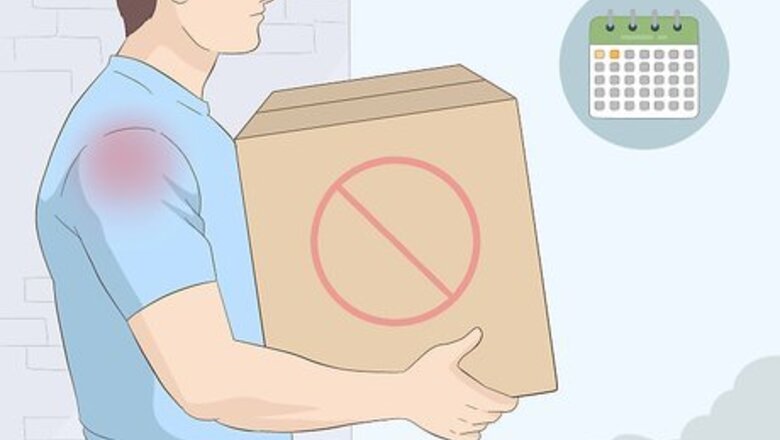
views
Managing the Pain at Home

Rest the shoulder for 24-48 hours after you first injure it. Strained and tensed muscles need rest to recover and repair damaged tissues. Avoid overexerting yourself or putting any unnecessary stress on your shoulder muscles for the first day or 2. For example, avoid lifting heavy objects or using repetitive movements (e.g., a hammering motion) while resting. This will help to reduce inflammation in your injured shoulder. Note that excessive rest is not advisable, since mobilization of the joints and muscles is important to promote good blood circulation. Avoid resting for more than 48 hours straight.Tip: If you’re a smoker, avoid smoking for these first 2 days of rest. Cigarette smoking can interfere with proper blood circulation and cause a delay in muscle healing and repair.
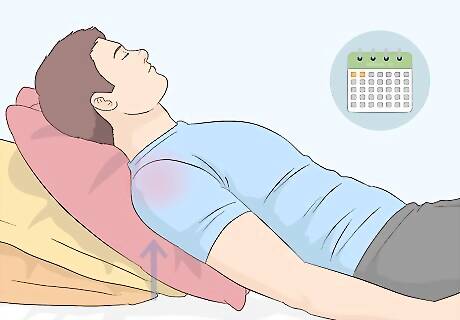
Keep the shoulder elevated for the first 48 hours to reduce inflammation. Use several pillows or a cushion behind your upper back to prop up your injured shoulder. Elevation helps with inflammation, as the effects of gravity help to pull down excessive fluid and blood that are lodged in a certain area, thus promoting proper circulation. If you’re lying in bed, elevate your back at a 45-degree angle for the most comfort.
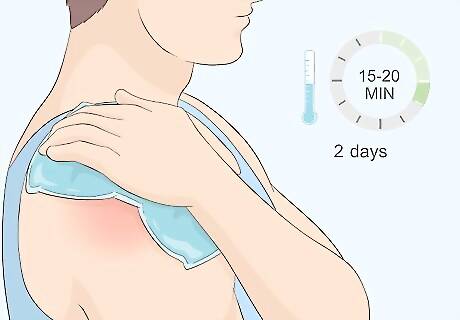
Apply cold packs to the affected shoulder during the first 24 to 48 hours. Apply the cold pack for 15-20 minutes at a time, repeating this process about 3-4 times each day. Wrap the cold pack in a towel or cloth before applying it to your shoulder. Cold temperatures cause the blood vessels to narrow, which can help to control muscle inflammation in the shoulder. By minimizing inflammation, further damage to the shoulder can be prevented. Note that cold packs are usually only beneficial for the first 24 to 48 hours after an injury.

Use heat packs on the affected shoulder after 48 hours have passed. After applying cold packs for the first 24 to 48 hours, the next step is to apply warm packs to promote muscle relaxation. Apply the warm pack for 15-20 minutes at a time and repeat the application 3-4 times each day as needed. Warm temperatures help to dilate blood vessels and improve blood circulation to the shoulder, minimizing inflammation and damage. Be careful that the warm packs are not too hot, otherwise they can burn your skin.

Massage the shoulder to relieve soreness and relax your muscles. Using your fingers, apply minimal to moderate pressure on the affected muscle and move your fingers in a circular motion. If your injury is in a location that’s hard to reach, have a friend or family member massage the muscle for you. If you can’t have someone massage the shoulder for you, place a tennis ball inside a sock and push the ball up against a wall with your shoulder muscle. Then, move up and down while pressing the ball against the wall to massage your muscle. Massage can be performed several times daily or as needed. You can also seek the services of a professional massage therapist to treat your shoulder pain. EXPERT TIP Eric Christensen, DPT Eric Christensen, DPT Physical Therapist Eric Christensen is a Physical Therapist based in Chandler, Arizona. With over a decade of experience, Eric works in both orthopedic and neurological fields and specializes in custom orthotic prescription and casting, vestibular reprogramming, and manual therapy. He holds a Bachelor’s degree in Exercise Science with a focus in Sports Medicine from Colorado State University and a Doctor of Physical Therapy from Regis University. In practice, Eric takes a developmental approach to rehabilitation utilizing the Selective Functional Movement Assessment. He uses functional movement patterning and manual therapy to return patients to prior levels of function. Eric Christensen, DPT Eric Christensen, DPT Physical Therapist A ball can massage your sore shoulders. Shoulder tightness can often be helped with a simple self-massage using a tennis or lacrosse ball. Lean your shoulder blade against a wall, then sandwich the ball between the wall and the sore spot for 30 seconds to release tension.
Stretching the Shoulder

Pull your arm across your chest to easily stretch your shoulder. Hold your arm out in front of you and place the opposite hand under your elbow. Then, pull your arm towards the opposite shoulder, bringing it across your chest. Hold this position for 30-60 seconds, then relax your arm. Repeat this stretch 3-5 times for each affected shoulder. Note that you can perform this stretch either standing or sitting down.Warning: Do not pull your arm all the way across your chest if this is too painful. Rather, stretch your shoulder as far as you comfortably can. The goal is to be able to perform this stretch without feeling any pain.
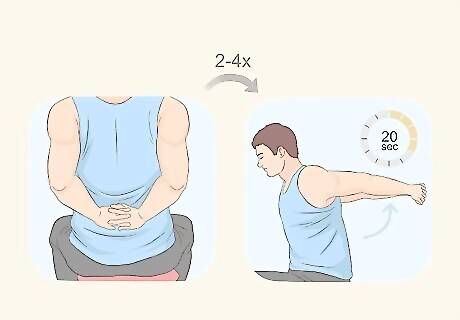
Do a seated chest stretch to stretch your chest and shoulders at once. In a seated position, clasp your hands together behind you, interlocking your fingers and turning your palms towards you. Gently lift your hands towards the ceiling as far as you can. Hold this position for about 20 seconds, then relax. Repeat this exercise 2-4 times as needed. This is a very effective way of stretching both shoulders instead of just one.
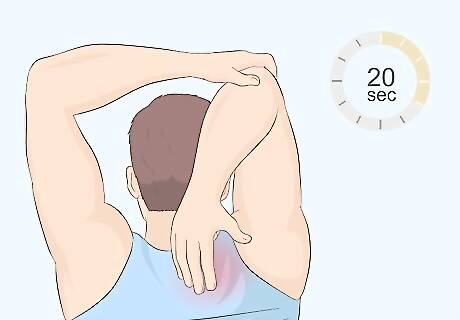
Perform a triceps stretch to stretch your upper arm and your shoulder. Place your hand on your affected shoulder and clasp your elbow with the opposite hand. Then, keeping your shoulders down, apply minimal pressure to your elbow to lift it toward the ceiling. Hold this position for 20 seconds, then relax. Repeat this stretch 2-4 times for the affected shoulder.
Getting Medical Help

Take NSAIDs for fast pain relief and to reduce inflammation. Non-steroidal anti-inflammatory drugs can be purchased over-the-counter and can be taken to alleviate pain and inflammation of certain muscles. Some of the most commonly used painkillers are as follows: Ibuprofen (Advil) Aspirin NaproxenWarning: Note that NSAIDs may not be right for everybody, such as people with aspirin allergies, heart disease, a history of upper digestive tract bleeding, NSAID sensitivity, or people who are taking blood thinners, such as Coumadin (warfarin), Xarelto (rivaroxaban), Pradaxa (dabigatran etexilate), and others. To be as safe as possible, consult with a doctor before you begin taking any medication for your shoulder pain.

Visit a doctor as soon as possible for severe or chronic pain. If the pain isn’t that intense, but doesn’t dissipate after 2-3 days, you should see a doctor for a professional diagnosis. Your doctor will be able to tell you what exactly is causing your shoulder pain and what you need to do to alleviate it. If you experience severe pain and inflammation of your shoulder or you are unable to move your shoulder, go to the nearest hospital, as the radiating pain may be a sign of an impending heart attack. Note that your best bet is to always get a professional diagnosis from a doctor before embarking on any treatment regimen.

Take any medications your doctor prescribes to treat inflammation. In cases of severe pain and inflammation, your doctor may prescribe you a corticosteroid or some other medication to treat your shoulder. Be sure to follow the exact dosage instructions that your doctor gives you to ensure your injury is properly treated. The most common corticosteroid prescribed by doctors is prednisone, which is usually prescribed to treat mild to moderate forms of inflammation.

Talk to your doctor about getting a cortisone injection. Cortisone is another type of steroid which manages inflammation. This step is not usually required, so you should only ask your doctor about it if your shoulder pain doesn’t respond to less drastic treatment. A cortisone injection is injected by your doctor into the inflamed area - in this case, your shoulder. When inflammation is diminished, pain is also reduced.
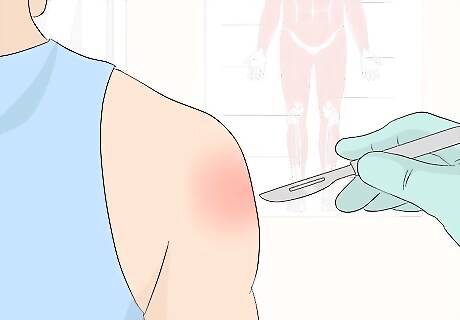
Ask your doctor if your shoulder will require surgery. If your pain is severe and doesn’t respond to other forms of treatment, it may stem from an injury that will require surgery in order to be completely healed. Note that this is not required in the majority of shoulder injuries and should only be necessary if your injury was caused by severe trauma. For example, if your shoulder was severely injured as a result of a car accident, it may require surgery to be fixed.



















Comments
0 comment